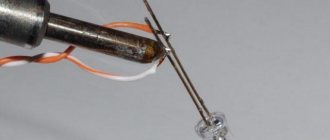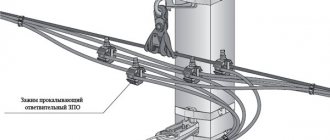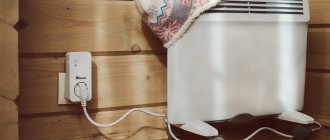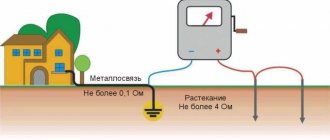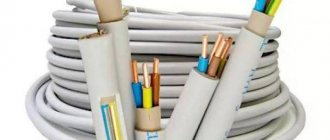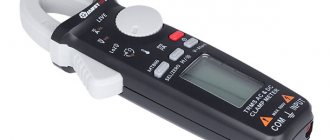A pyrometer is an advanced device for determining the temperature of any object based on an infrared sensor that reads invisible infrared radiation, converts the readings into temperature ones and displays the resulting number on the display. The maximum measuring range is 1000°C. It is also known as a non-contact digital thermometer or an infrared gun.
Pyrometer - non-contact digital thermometer
We recommend that you pay attention to other instruments for measuring temperature.
Although pyrometers are relatively new to industrial use, they are increasingly used for temperature measurement because they are convenient, accurate, and safer than other types of temperature sensors.
A pyrometer can be extremely useful for troubleshooting systems where excessive heat may be a contributing factor. For example, a technician can use a pyrometer to detect a hot spot on a circuit board without disconnecting the circuit from the power source or in the immediate vicinity of live circuits. The pyrometer is also perfect for troubleshooting any equipment with rotating parts, since measuring with it does not expose the Kipo worker to the danger of contact with rotating parts.
Where is a pyrometer used?
However, its scope of application is not limited to these industries only. It is used to measure the temperature of moving parts of mechanisms. For example, to find out whether the bearing on the engine is heating up or not.
They detect temperature differences on adjacent surfaces - compressor cylinders in refrigeration units, or individual parts inside a car.
Let's say your engine is overheating for an unknown reason and you need to find out why. To do this, use a pyrometer to first measure the temperature at the outlet pipe of the thermostat and compare it with the temperature of the radiator.
If the difference is very large, then the thermostat is most likely to blame.
Another application is measuring the temperature of hot metal for its proper processing.
If you do this with classic thermometers, then you will lose precious time heating the thermocouple itself. And with a wireless thermored pyrometer, all this takes literally a moment.
Here is a summary graphical thumbnail and a breakdown of the capabilities and areas of application of pyrometers:
Decoding and features
Top 3 best pyrometers from AliExpress
Cheap but functional pyrometers can be purchased online through AliExpress. Although the reliability of such devices is considered lower than that of devices from branded stores, they usually cope well with everyday tasks.
Habotest HT650A
A convenient home pyrometer with a circular sight is suitable for determining not only temperature, but also humidity. The maximum threshold for the device is 380 °C; the infrared device operates on a non-contact principle.
The cost of Habotest is from 1400 rubles on AliExpress
Norm 400/600
The infrared device is capable of measuring temperatures up to 400 °C, suitable for any purpose - from medical to household. Despite its low cost, it has a small error of about 1.5%.
The cost of the Norm 400/600 pyrometer is about 4000 rubles
DT-8809C
A mid-budget device from AliExpress measures the temperature of a person up to 43 °C and of inanimate objects - up to 100 °C. It is highly accurate, easy to use, and measurements can be taken from a distance of 5-10 cm.
You can buy DT-8809C from 4000 rubles
Why the pyrometer is lying - reasons
This device is certainly good, but let’s take a closer look at the question of how to use it correctly. After all, simply pointing a laser beam and reading the readings on an electronic display does not always guarantee or give correct results.
There are many errors in measurements that most users are not even aware of. Measuring temperatures using an optical device differs from measuring temperature using contact devices.
Here are the main mistakes that beginners make:
- the material from which the measurement item is made is not taken into account
- measurements are taken through glass or in a dusty, damp room
- the temperature of the pyrometer itself differs significantly from the ambient temperature
- measurements take place too far from the object, without taking into account the cone of beam expansion
- thrifty “specialists” try to work with a device like a thermal imager over large areas, without taking into account the update frequency of the device’s readings
Let's consider all these points in more detail.
Operating principle
The operation of devices of this type is based on the occurrence of infrared radiation and determining the absolute value of the wavelength energy emitted in the infrared spectrum.
The instrument is directed to a distant object, the distance to which is limited only by the diameter of the spot being measured and the composition (“purity”) of the air environment surrounding the object. Measuring the characteristics of an object's radiation (its intensity and spectral composition) with a pyrometric device indirectly determines the temperature of its surface.
The operating principle of the pyrometer determines the main functionality of the instrument:
- measuring the temperature of remote (inaccessible or difficult to reach) objects, as well as the temperature of their moving elements;
- analysis of the temperature regime of energized objects when contact measurement methods are not possible;
- express recording of rapid temperature changes on the surface of an object body;
- study of objects with low heat capacity or thermal conductivity.
Using a pyrometer at industrial facilities and in everyday life does not present any difficulties: the instrument is aimed at the object being examined, temperature data is measured and recorded on the display in a matter of seconds by pressing and holding the trigger.
Beam reflection error and emissivity
When you measure degrees with a contact thermometer, you are in fact only measuring body temperature. But if you try to do the same thing at some distance, then you will simultaneously measure all those waves and rays that, regardless of your desire, somehow fall into the pyrometer lens.
And not only the radiation that the body emits gets there.
And if you don’t know how to set up the pyrometer correctly, then the device will show complete nonsense.
What kind of interference is this that affects the measurement accuracy? When working with a tool, 3 components fall into its lens:
- rays that the body passes through itself
- the rays it emits (this is its own temperature)
- reflected rays from surrounding objects
Transmitted rays are usually not taken into account in calculations, because most bodies are simply opaque to them. Therefore, only two quantities are taken into account:
- emissivity or emissivity factor
- reflection coefficient
Moreover, you should be more interested in the coefficient. radiation, since this is the very temperature that the body has.
The emission (radiation) coefficient is a value that shows what percentage of the total radiation is heat. The rest may be reflected light or light that passes through the body.
In this regard, it is worth noting that the pyrometer cannot measure the temperature of an object that is behind glass, in smoke or fog.
The glass for the optics of the device is not a transparent element, but a separate object that emits its own radiation. Therefore, it must be removed from the measurement area.
Most bodies and surfaces around us have an emissivity of 0.95. These are the factory settings that are initially set on the devices.
Moreover, on cheap models, they are hard-wired into the software component once and for all, and you cannot change them. On more expensive devices, this coefficient. can be adjusted manually.
Why is this necessary? For bodies of different composition and properties, coefficient. radiation is different. And the higher it is, the more accurate the temperature measurement results with a pyrometer will be.
For example, if it is K=0.95, then you only have 5% left for reflection. The error that these same 5% will introduce will be extremely small and can be neglected.
But the fact is that in practice, both in electricity and in heating, we are of little interest in objects with a high emissivity. These include walls, floors, table surfaces, pieces of furniture, etc.
Using a pyrometer, we primarily measure copper or aluminum contacts, radiators, pipes, chrome heated towel rails, etc.
All of them have a bright shiny surface, which introduces a significant error into the measurement data. There is a certain nuance to this.
How to choose the right pyrometer
The choice of device depends primarily on where and for what purposes it will be used. Some models are better for measuring body temperature, while others are designed for culinary purposes.
Which pyrometer to choose for your home
The most popular in home use are portable infrared devices. A stationary device operating from the network is unlikely to be useful for domestic purposes, despite its high accuracy. When choosing a pyrometer for your home, you need to consider:
- temperature range, in everyday life there will be a sufficient range from - 50 to 380 ° C;
- accuracy, the error of the device should be no more than 3 degrees;
- range - pyrometers can be contact or non-contact; when using the latter, you need to take into account the optical resolution, or the required distance to the object;
- speed, in everyday life it is convenient to use devices with a response from 0.1 to 0.15 seconds.
Also, when comparing pyrometers and choosing the best one, you can take into account additional parameters. Some models can measure humidity. It is useful if the device is able to save the results of tests performed in the built-in memory.
Which pyrometer is better to choose for a pastry chef?
When choosing a pyrometer for baking in a workshop or at home, you can buy a non-contact device with a range from - 50 to + 400 °C. But models with a thermocouple perform best in cooking; they are connected to the main unit and measurements are taken using the contact method to obtain the most accurate results. Then the test is repeated remotely to compare the indicators; the difference usually reaches several degrees.
In cooking, contact pyrometers with a thermocouple remain the best
How to choose a medical pyrometer
Medical devices are often used instead of conventional thermometers. You need to select a device according to the following parameters:
- contact or non-contact action, devices of the first type are more accurate, although the second can be used for several people without disinfection;
- accuracy, for a medical pyrometer the minimum error is important;
- functionality, it is useful if the device is equipped with a sound signal and can indicate the completion of the measurement.
Important! The medical device does not require a large temperature range.
How to choose a non-contact infrared pyrometer
The best pyrometers for measuring temperature using a non-contact method are very popular in everyday life. Such devices demonstrate high accuracy and are versatile. They can also measure very hot, dangerous or hard-to-reach objects.
When choosing, you need to look at several characteristics:
- Range. If you only need to determine body temperature and weak thermal radiation from surfaces, you can choose a device with small values. For culinary use, you need to buy a model with a wide range, and it is desirable that even very high temperatures are kept away from the maximum possible readings of the device.
- Spectral sensitivity. It is better to choose a device that operates on short waves; it is suitable for most household measurements.
- Chroma. Usually, single-color pyrometers are sufficient for home use. Two-color models should be chosen if you need to evaluate the temperature of very small and hot objects, as well as objects whose radiation is partially blocked by any contamination or obstacles.
Infrared devices equipped with a laser sight are considered the best. They help measure the temperature of an object at a specific selected point and thus reduce the likely error.
How to choose a pyrometer for measuring temperature
If the device is to be used instead of a thermometer, first of all you need to decide on its type - contact or non-contact. Devices from the last category are recommended for young children. But for adults and teenagers it is better to use contact pyrometers - frontal or ear. They give more accurate readings and are almost as good as mercury thermometers.
Difference in readings when measuring heated and cold bodies
For example, if your object has an ambient temperature, then it emits and reflects approximately the same temperature. But if it is heated, an error will immediately appear, significantly distorting the real data.
To verify all of the above, you can conduct a simple experiment yourself. Take a shiny pan and some book.
Next, take measurements on them with the same pyrometer. To increase the accuracy of the experiment, try to take measurements at one point.
Your results will definitely not be the same, although you won’t see much of a difference. If you double-check this matter with a contact thermometer, the deviations will be only 2-3 degrees.
But all this will be true only at room temperature of the objects. What happens if you pour hot water into a pan?
In this case, the measurements will immediately go wrong.
Hot pot temperature
Real temperature with correct coefficient
This suggests that the temperature of heated smooth shiny surfaces cannot be measured simply by a pyrometer.
Therefore, when videos show how easy it is to determine the temperature of batteries or contacts using a non-contact meter, do not trust this advertising too much.
Types and classification
Depending on the functional characteristics, there are several classifications of pyrometers.
According to the essential method used in the work:
Optical pyrometers are divided into:
- Brightness;
- Color, or multispectral.
Depending on the aiming method, devices with optical or laser sights are distinguished.
Based on the emissivity used, pyrometers with variable and fixed coefficients are distinguished.
Depending on the possibility of transportation, pyrometers are divided into stationary and mobile (portable).
Based on the possible measurement range, the following are distinguished:
- low temperature (-35…-30 °C);
- high temperature (+400 °C and above).
Table of emissivity coefficients of different materials
In most cases, you can’t just point the beam, pull the trigger and immediately get the correct measurement result on the display. On shiny heated objects, all pyrometers begin to lie strongly.
And this error depends directly on the emissivity. Here is a detailed table of emissivity coefficients of various materials. These data must be used every time when taking measurements with pyrometers.
To increase the accuracy of measurements, it is worth buying more expensive models with the ability to set these coefficients. inside software settings.
There are two ways to measure the temperature of materials that are not in the table. Use a “target” with a known coefficient, placing it on the object being measured.
Or first determine the surface temperature with a contact thermometer, and then change the values in the device to achieve an approximate match.
Rating of the best inexpensive and accurate pyrometers of 2022
Professional grade devices can be quite expensive. Budget models, which nevertheless maintain good quality and measurement accuracy, are of great interest.
CEM DT-608
The compact device is suitable for both measuring body temperature and assessing the thermal radiation of objects. Operates in the range of 0-60 °C, demonstrates good accuracy.
Advice! To obtain the most reliable results, users recommend taking measurements several times in a row and taking the average value.
Infrared CEM DT-608 costs from 2000 rubles
Megeon 16280
An inexpensive pyrometer with a laser sight takes measurements in half a second and shows accurate results on the display. Suitable for determining surface temperature - 32-280 °C, gives a minimum error of 1.5%.
The price of the Megeon pyrometer starts from 1400 rubles
Megeon 16400
Another good pyrometer for home use takes measurements up to 380 °C. It also detects negative temperatures down to -20 °C and is precisely aimed at the desired location using a laser. Measurements are carried out without contact with the surface, so the device is very durable.
Megeon 16400 can be bought for 1300 rubles
How to measure temperature correctly using a non-contact method
The process of correct measurement with a pyrometer will look like this.
Determine the material from which the item is made (steel, copper, aluminum). Next, look for its emissivity in the table and enter this correction into the device itself.
And only after that you direct the beam of the infrared pyrometer to the object.
With this measurement you will actually get results close to the actual temperature. Well, those devices in which the coefficient is rigidly set by the factory = 0.95 will simply lie with every measurement.
No matter what angle you direct the beam at, no matter how close you bring the device to the surface, there will be distortions in any case. And here we are no longer talking about one or two degrees.
The error can be tens of units!
Advantages and disadvantages
The main advantage of an infrared pyrometer is its relatively simple design. Due to this feature, it has good reliability, small dimensions and low cost.
The second advantage of the device is its high resolution and the ability to determine the temperature of “cold” bodies from -50 to 400°C.
A significant disadvantage of a pyrometer is the dependence of the measurement result on the emissivity of the object’s surface material and their state of aggregation. We have to compensate for this by adjusting the emissivity.
At what distance can a pyrometer be used?
By the way, it’s worth mentioning separately about the distance. Essentially, the pyrometer beam measures the temperature of a certain point or circle.
At the same time, do not confuse the laser pointer point and the measurement spot. These are different things. They differ in size by several orders of magnitude.
If you are at a great distance from the object, then this spot or circle increases in area. Accordingly, for more accurate measurements, the device should be brought as close as possible.
For example, in most models, the cone they see has a ratio of 12 to 1. That is, at a distance of 1.2 meters, you can measure the temperature of a body with a diameter of 10 cm, no more, without error.
Although this is considered a normal parameter, it is better to bring the device closer. Since when measuring, your hand may tremble, or the scope may go astray, and as a result, along with the required surface, you will also measure the neighboring one, which will contribute to the overall readings.
As indicated in the photo below, it is not advisable to measure the temperature of modular machines. Instead of one phase, you will unwittingly capture the neighboring one, which will introduce an error into the data. The distance between them is too small.
The same applies to measurements of terminal blocks and clamps. You need to bring the pyrometer as close to them as possible.
Rating of laser non-contact pyrometers 2022
To understand which pyrometer is best to buy for your home, you should read the review of popular models. The most popular among buyers are non-contact devices with a laser sight.
ADA TemPro 700 A00224
A relatively inexpensive device from the professional category is suitable for detecting heat leaks in the house. Supplied in a durable case with a long handle, it is resistant to temperature changes and is characterized by highly reliable results. Equipped with a laser sight that allows you to take pinpoint readings.
Pyrometer ADA TemPro 700 can be purchased for 3,500 rubles
Testo 830-T1
The device is suitable for measuring low and high temperatures, and works not only with solid objects, but also with liquids. Thanks to the built-in laser, it can take readings from both large areas and small areas. Capable of taking measurements in the range from - 30 to + 400 °C.
Price Testo 830-T1 starts from 4000 rubles
Bosch PTD 1
The universal device determines the air and surface temperature, as well as the humidity level in the room. Used for technical purposes, helps identify heat leaks. Takes measurements from -20 to 200 °C on the surface, and as a room thermometer displays readings from -10 to 40 °C.
Reliable Bosch PTD 1 costs an average of 8,000 rubles
Measuring temperature in the cold
Also, don’t forget about the ambient temperature. Many users complain that certain models of pyrometers begin to lie shamelessly at temperatures below room temperature.
That is, they take the device, go into the boiler room, basement or garage and there they try to “shoot” the temperature with it. As a result, they get completely strange results.
The point here is that any electronics, especially measuring ones, cannot be used until the temperature of the device is equal to the temperature of its environment.
Take the pyrometer outside or into the garage, leave it for 10-20 minutes, and only then start taking measurements.
Of course, we are not talking about the fact that the device needs to be frozen to sub-zero temperatures. Here he would most likely lie shamelessly, since he was not designed to work in such conditions. In other cases, thanks to this “exposure”, the error decreases.
Stationary modification
These models differ significantly in layout and represent a cylindrical optical module, inside of which a measuring sensor is enclosed. This component is connected by a special durable cable to an electronic control module, which is equipped with a monochrome liquid crystal display and a push-button control menu.
The unit is placed in a closed panel, power and signal lines are connected. Subsequently, the value of the output current (or voltage) is transmitted via wires to the computer using special logic tools (controllers) and specialized software. This scheme is more convenient, since the screen of the electronic module is small. It is difficult to distinguish the displayed readings.
Stationary pyrometers are suitable for use in various industries. They are manufactured with a wide range of measurable limits. Thanks to this quality, the device allows you to control any technological process related to temperature.
It can be used in difficult or even aggressive environmental conditions (dust, high temperature, humidity, etc.). This is possible because the optical element is enclosed in a sealed stainless steel protective housing with water cooling or air purging.
Stationary pyrometers are equipped with laser aiming systems and can be equipped with additional accessories. For example, a proprietary mount, a protective casing, optics and other elements.
Data update time
Another important parameter of a pyrometer, in addition to accuracy, is the frequency of updating readings. It is especially important to have a high frequency when scanning and comparing temperatures over large surfaces.
In this case, the device imitates the operation of a thermal imager and looks for maximums and minimums.
Results of 250ms or less are considered very good indicators. Only well-known brands have such parameters. For example, the same Fluk.
Application area
Pyrometers have found quite wide application in those industries where a large number of heating devices are installed. In the field of construction and thermal power engineering, they are used to calculate the heat loss of structures, including a pyrometer that helps to identify damage to thermal insulation.
In industry, such devices make it possible to analyze the temperature of various processes remotely. This is necessary, for example, in mechanical engineering, metallurgy and other industries.
Thus, electricians check the heating level of wire connections, and car mechanics check the heating of car parts. Pyrometers come to the aid of scientists during various studies or experiments: this is how they determine the accuracy of the temperature of substances and bodies.
In everyday life, people use such devices to determine body temperature, water, food, etc.
Specifications
The pyrometer has a number of parameters that characterize its functionality. The choice of the desired device model is carried out according to their values. Let's look at the main ones.
Optical resolution
This is the name given to the ratio of the diameter of the tool spot to the distance to the object. This function depends on the angle of the device’s lens: the larger it is, the larger the area it can cover. The most important factor in the accuracy of the measurement is the application of the spot exclusively to the surface material. If the area is exceeded, the measured value will likely be inaccurate.
Operating range
The operating range of the device depends on the pyrometric sensor and often varies from -30 °C to 360 °C. Thus, almost all types of pyrometers are suitable for domestic use, if we take into account the maximum temperature of the coolant in the heating system up to 110 °C.
Error
The error implies the level of possible deviations in temperature values and depends on the accuracy of the pyrometer. On average, permissible deviations do not exceed 2% of the norm.
Emissivity
This parameter represents the ratio of the power of the current temperature radiation to the same indicator of the reference absolutely black body.
REFERENCE. For matte materials, the emissivity is 0.9-0.95 . For this reason, more devices are selected specifically for this value. The result will differ noticeably from the real one, for example, in the case of measuring the degree of heating of the surface of shiny aluminum.
For more accurate measurements, many models are equipped with a laser pointer. In this case, the light beam is not placed in the center, but indicates the optimal boundary of the measurement area.

